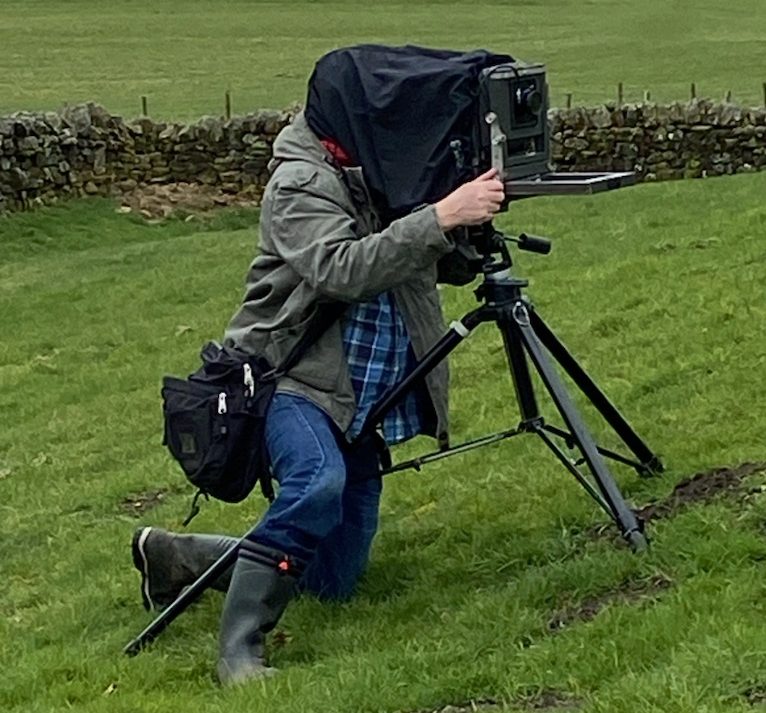(Wherein our intrepid blogger reports on two British-made cameras and presents the output of his perambulations in the northern part of England … )
It was the best of cameras; it was the worst of cameras …
I have two models of the Agilux Agifold range of cameras in my collection, a Mark III and a Mark II; I’ve used the Mark III a couple of times and decided recently to run a film through the Mark II to write a comparison article for this blog.
Both cameras are British-made medium format folders with uncoupled rangefinders, from the late 1940s and 1950s.

First I will look at the Mark II – see above – which came into production in 1949.
You may notice that there doesn’t appear to be a lever or button to open the camera; this is achieved by moving the top component housing the viewfinder and rangefinder to the left, which causes the lens to shoot out like a canon.

The aperture range is f4.5 – f22 and the shutter speeds are B,1s, 1/2s, 1/5s, 1/25s, 1/50s, 1/100s, and 1/150s. The lens is a 90mm “Agilux Anastigmat”.

I think this is the only camera I’ve owned that has both a red window and a green window. According to the manual, the red window is used when the camera is loaded with panchromatic film and the green window is used with orthochromatic film. I would have preferred to close the red window when it was not actually needed to check the film winding, but closing the red window opens the green window, so I chose to leave it open.
You can see here that the camera is in bad shape cosmetically, with the leatherette covering peeling off. Since I was given it for nothing by my father, I can’t complain.

The back removes completely for film loading; for some reason the film transport route is way too tight (probably a misalignment of the pressure plate) which means (a) it’s really, really hard to wind the film advance lever, and (b) the film gets scratched against the vertical rods.
The effects of this can be most easily seen on this unexposed frame (I missed the frame number in the red window resulting in a wasted frame). Without the masking effect of an image we can see horizontal lines, the word “Kodak” (this was TMax film) and a frame number.

Despite these handling difficulties, I did manage to get a few images from one roll of TMax 100 exposed at Beamish Museum on a very dull December day:
I am sure that many of my readers would regard the film-scratching problem as a challenge to be solved, and would if necessary disassemble the camera and reassemble it as good as new. For me however, wiring a plug is the limit of my DIY capabilities, and I have other cameras I can use, so this camera will be categorised as “glad-I-used-it-once-but-not-in-a-hurry-to-use-it-again”.
By 1955 the Mark II was succeeded by the Agifold Mark III, which was, in my opinion, much more capable and pleasant to use.

I spotted this camera for sale on a stall at Tynemouth Market, and was pleased to acquire it for a very reasonable £15. I was attracted by the “art deco” styling on the nameplate and rangefinder section, and everything seemed to work.
Compared to the Mark II, the shutter speeds are expanded to go up to 1/350s, with the aperture range staying the same. The Mark III is much lighter than the Mark II and seems less industrial and more of a consumer object. The lens has changed to a 75mm model, and a sliding cover has been added for the red window.
Both cameras have something called an “extinction meter” – I thought this was a misprint at first, but that is the correct name. To estimate the required exposure, you look through a window and ascertain how many vertical bars you can easily make out – the more light is available, the more bars will show up. Then you transfer that reading to the very fiddly dials on the right hand side of the top plate, and eventually come up with the required exposure at about the time any non-stationary subject has moved out of view !
I did plan to test out this mechanism to see how it compared with an external meter, but I abandoned this plan when I read this sentence in the manual:
“Do not expect to get an accurate reading until you have been in the same intensity of light for about five minutes or so, to allow the eye to make a natural adjustment to the surrounding light”.
I’m all for the concept of “slow photography” but this would be taking slowness too far ! Both cameras also have an uncoupled rangefinder, which doesn’t seem too accurate. Whilst I’m sure they are capable of calibration, I prefer to guess for scale focussing, or I could use my external “Watameter” rangefinder, which is easy for the user to calibrate.
Here are a few images taken on TMax 400 film on this camera, around Northumberland and York.
I’ve put the Mark III Agifold into the category of “Happy-to-use-it-occasionally-when-I-fancy-a-change”.


















Hello Mr Allen
I have just read your article on the Agifold Mark II. I’m not sure if my camera is working but it was interesting to see what images could be taken on it.
Thanks for the interesting article
LikeLike